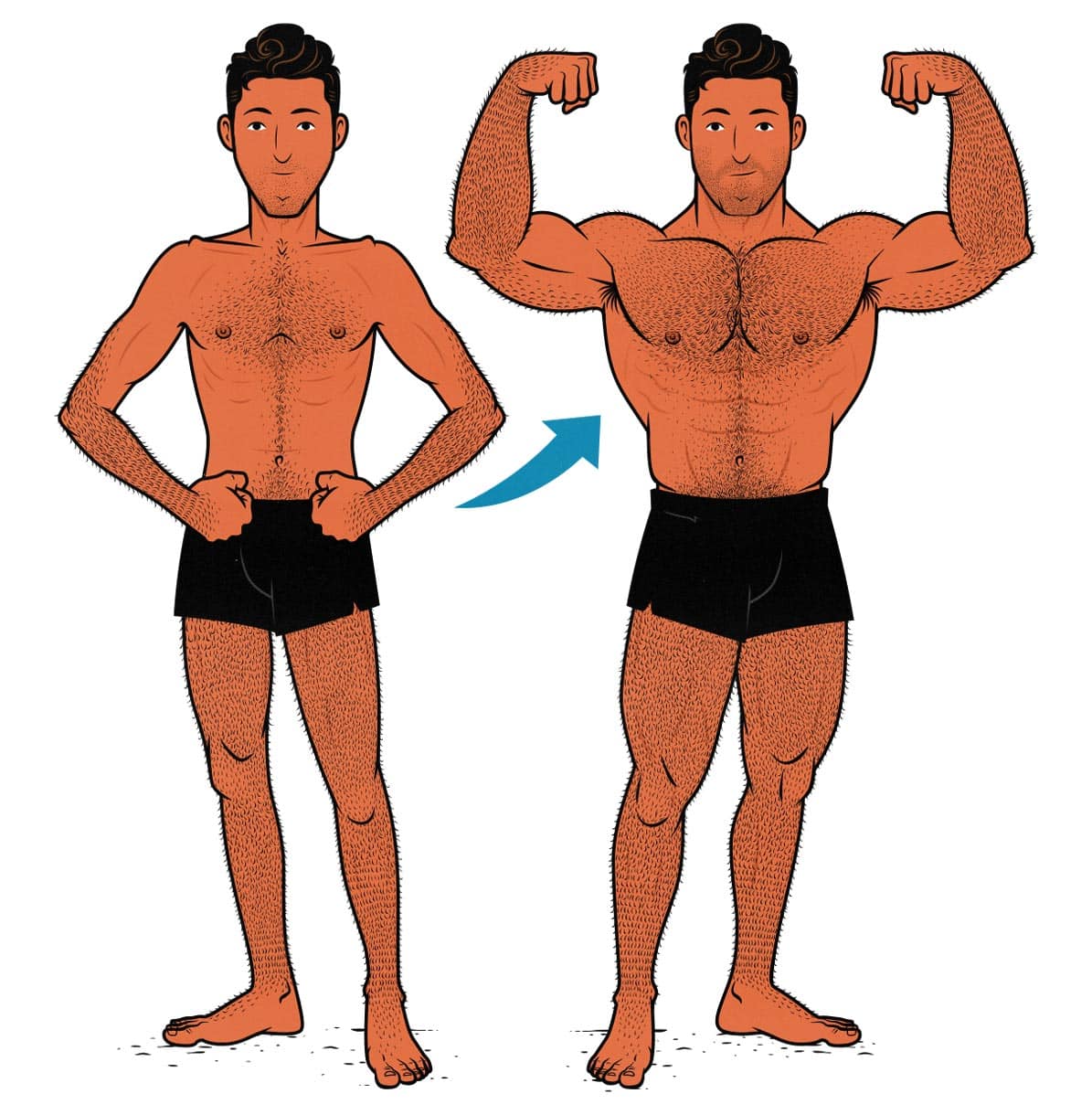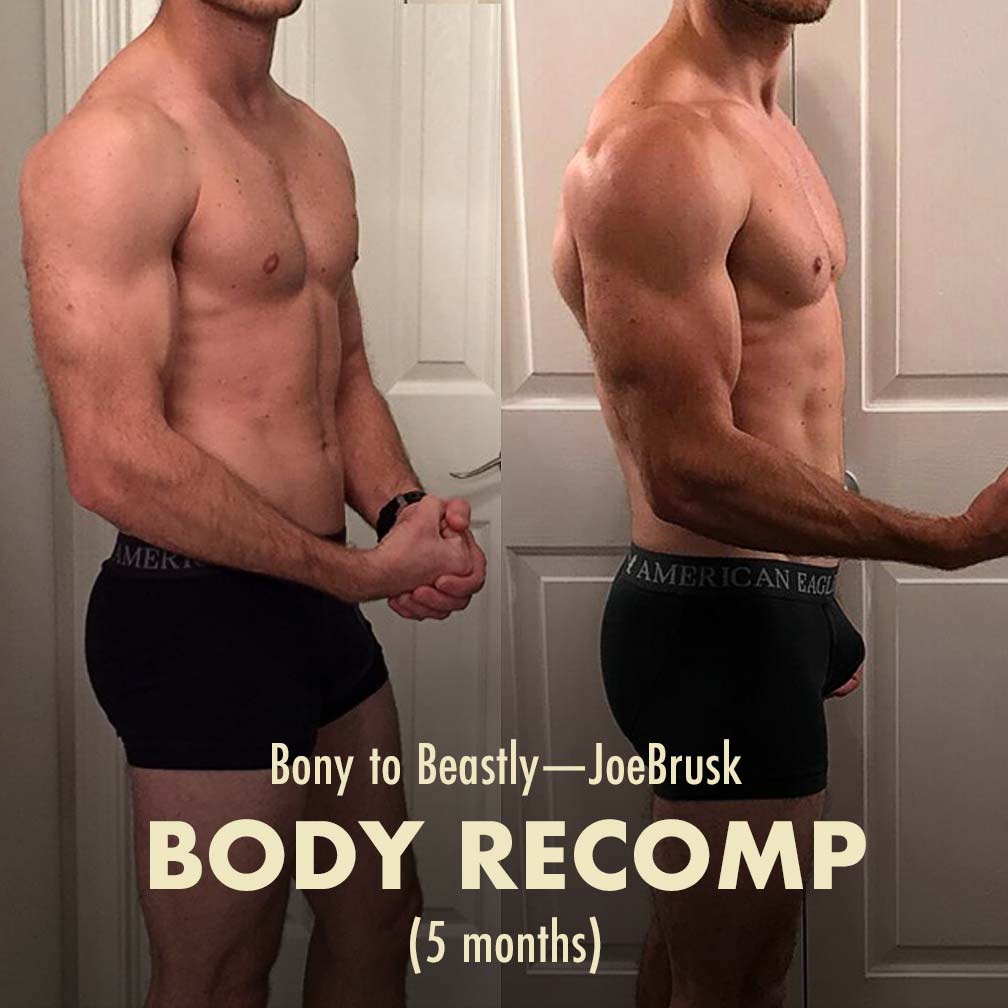
Do You Need to Bulk to Build Muscle?
Bulking is when you eat in a calorie surplus to give your body the nutrients it needs to grow. Not everyone needs to start by bulking. If you’re a skinny-fat or overweight beginner, you can get the energy you need from your extra body fat.
- If you’re thin or lean, then you don’t have any extra body fat to burn, so you’ll need to get it from your diet. You’ll need to eat in a calorie surplus. You’ll need to bulk to build muscle.
- If your goal body weight is heavier than your current body weight, then you need to eat in a calorie surplus to get there. That means you need to bulk.
- If you’re an experienced lifter, your body won’t grow as readily as it used to. You might need to get into a calorie surplus to continue making gains. Again, you need to bulk.
The problem with bulking is that it increases your risk of gaining fat. Any surplus calories that aren’t invested into muscle growth can spill over into body fat. That’s why so many people fear it. Those fears are largely unfounded, but I understand the hesitation.
In the rest of the article, we’ll go over the research, explain why a calorie surplus improves muscle growth, and then teach you how to bulk up leanly.

What is Bulking?
There are a few different ways to define bulking. When someone criticizes bulking, they’re usually using one of the less favourable definitions. So, before we can discuss the pros and cons, we need to get on the same page about what bulking actually means.
- Bulking: Eating in a calorie surplus to gain weight and encourage muscle growth. What separates bulking from regular weight gain is that bulking has an emphasis on gaining muscle, not fat. This means that, by definition, bulking is the leanest way to gain weight.
- Lean Bulking: Eating a small calorie surplus to reduce the risk of gaining fat. Some people call this “maingaining” or “gaintaining,” but if you’re gaining weight, you’re bulking. It’s sometimes confused with a “clean bulking.”
- Aggressive Bulking: Eating in a large calorie surplus to support harder training and a faster rate of muscle growth. This is the fastest way to build muscle, but it also carries a much higher risk of gaining fat.
- Dirty Bulking: You eat whatever you want, usually including copious amounts of junk food. As you can imagine, it isn’t usually very healthy, and it can easily lead to extra fat gain.
- Dreamer Bulking: Eating in a calorie surplus without gaining much muscle. It’s similar to regular weight gain. It’s usually some combination of poor training, poor diet, or eating far too many calories.
- Cutting: Eating in a calorie deficit to lose weight and burn fat. What separates cutting from regular weight loss is that cutting has an emphasis on losing fat while maintaining or gaining muscle.
- Body recomposition: Building muscle and losing fat at the same time. You can get body recomposition while bulking, cutting, or staying at the same body weight.
- Maintaining: When you casually lift weights and eat a good diet without intentionally gaining muscle or losing fat. Most strong, healthy people spend most of their lives maintaining their progress.
These definitions should burn away most of the strawmen. If someone says bulking makes you fat, they’re talking about dreamer bulking. If they say “gaintaining” is better than bulking, they’re talking about the benefits of lean bulking.
Is Bulking the Best Way to Build Muscle?
My Skinniness Forced Me to Bulk
I started off underweight. I was 6’2 and 130 pounds, and my goal was to gain 20 pounds of muscle, getting up to 150 pounds. I have a small stomach, a meagre appetite, and a fast metabolism, so the last thing I wanted to do was bulk. But my goal included weight gain. I had to.
If I was a skinny-fat 150 pounds, I could have taken a different approach. I could have tried to burn off the fat and replace it with muscle, maintaining a similar body weight. That would have worked for a little while.
Once I bulked up to 150 pounds, I realized I wanted to be 170 pounds. Then, at 170 pounds, I decided to try for 190 pounds. And then I really wanted to get a 3-plate bench press and a 5-plate deadlift, so I pushed it a little further. That’s how I gradually bulked up from 130 pounds to 200 pounds.

I was only able to build muscle while bulking. Over these past ten years, I’ve spent 2–3 years bulking. That’s when I made all of my progress. During the other 7–8 years, I was lifting weights and eating a healthy diet, but I didn’t gain any muscle at all. I’m not an over-fat beginner, so without extra calories from my diet, I can’t gain weight or build muscle.
Building Muscle in a Calorie Deficit (Cutting)
If you’re overweight or skinny-fat, you don’t need to bulk. You have extra energy around your stomach. You don’t necessarily need extra energy in your stomach. They have a surplus of body fat, and so their body won’t fight to keep it (study, study).

For example, this study found that most people who lifted weights, did cardio, and ate in a calorie deficit could build muscle while losing fat. We see this in our members all the time. When people have extra fat to lose, they can build muscle as they lose it.

However, although it’s realistic to gain some muscle mass while cutting, it’s still slower and harder. There are a few reasons for that:
- Eating fewer calories reduces muscle protein synthesis, even when protein intake is high. That makes it much harder to gain muscle mass. This study shows that a calorie deficit of 500 calories per day (losing about a pound per week) decreases muscle-protein synthesis by 20%.
- Prolonged calorie deficits reduce testosterone production (study). Fluctuations within the normal testosterone range don’t always affect muscle growth or fat loss. Still, generally speaking, higher testosterone levels make it easier to improve body composition. Short periods of mild calorie deficits shouldn’t be much of a problem, but it’s certainly not ideal.
- Eating fewer calories increases growth hormone production. When people eat in a calorie deficit, hypertrophy training causes their growth hormone levels to rise higher than normal (study). Growth hormone production also increases during fasting periods. That’s why intermittent fasting increases growth hormone production (study). However, despite its name, growth hormone has a fairly weak association with muscle growth (study).
- Reduced activation of mTOR (study), which controls muscle growth and breakdown, controlling whether we gain or lose muscle. So when trying to build muscle, we want more mTor, not less.
- Lowered immunity (study). Another side-effect of being in a prolonged calorie deficit, especially when already fairly lean, is that it can reduce our immunity. Exercise improves our immunity, but we still need to be more cautious with how hard we train.
Building Muscle at Maintenance (Body Recomposition)
Building muscle is easier when you aren’t in a calorie deficit. Everything runs more smoothly. Nothing is suppressed. You can build muscle by following a good hypertrophy training routine, eating a nutritious diet, getting enough sleep, and improving your lifestyle.

For example, this study found that participants who were given a workout, diet, and lifestyle program could gain muscle and lose fat while staying at the same body weight. In fact, if we look at overweight beginners, it’s unclear if there’s any benefit to eating in a calorie surplus. They build muscle perfectly well either way.
If you’re already under 15–20% body fat, you aren’t overweight, so you don’t have “extra” fat. Your body won’t necessarily want to lose what little you have. You might still be able to achieve body recomposition, but it will be a longer, slower, and more finicky process.

But you can’t recomp forever. Eventually, you’ll run out of extra fat. One day, you’ll hit a plateau. That’s when it’s time to bulk.
Building Muscle in a Surplus (Bulking)
Most bodybuilders, powerlifters, and athletes go through periods of intentionally gaining weight. Bodybuilders call it their “off-season,” powerlifters call it a “massing phase,” and casual lifters call it “bulking season.”
Bulking brings several physiological advantages:
- Consuming a calorie surplus causes muscle growth (study, study). Most people who gain weight build around one pound of lean mass for every two pounds of fat they gain. This makes their body composition worse, of course. They become overweight. But they’re still gaining muscle—without lifting weights, eating a good diet, or living a healthy lifestyle.
- A calorie surplus may increase testosterone, IGF-1, and insulin (study). Mind you, these small increases in anabolic hormones, while nice, may not lead to measurable amounts of extra muscle growth (study, study). It’s hard to say.
- Eating more calories means eating more nutrients. More protein, carbs, healthy fats, fibre, vitamins, minerals, phytonutrients, and probiotics. Not only will you have more energy to invest in muscle growth, but you’ll also have more of everything.

Numerous studies show rapid gains in lean muscle mass when participants eat in a calorie surplus, while those eating at maintenance barely gain anything.

For instance, in this 8-week study, some participants were given a mass gainer shake, driving them into a calorie surplus. They gained 7.5 pounds of lean mass while losing 0.5 pounds of fat. The control group lifted weights but wasn’t told to increase their calorie intake. They failed to gain a significant amount of muscle mass.
Most studies show tremendous amounts of muscle growth from bulking. For instance, when we were researching whether keto was good for bulking, we came across this study:

The participants following the ketogenic diet couldn’t get into a calorie surplus, and so they struggled to build muscle, even though they were following a good bulking program. The high-carb group succeeded at eating enough calories, allowing them to gain three pounds of lean mass in eight weeks while losing a pound of fat.
Bulking Maximizes Muscle Growth
There’s an overwhelming amount of evidence showing faster rates of muscle growth while bulking. This study recommends a calorie surplus of at least 200–300 calories to maximize muscle growth. In this study, they recommend a calorie surplus of at least 350–500 calories per day to maximize muscle growth.

The Three Best Ways to Bulk
Let’s go back to the three ideal ways of bulking. If you can understand the pros and cons of each, you can venture down the path that suits you best.
- Classic Bulking: This is a balanced way of bulking that tries to maximize muscle growth while minimizing fat gain. It combines a rigorous hypertrophy training program with a modest calorie surplus and a nutritious diet.
- Lean Bulking: bulking with an emphasis on keeping your gains lean. This is done by following a good hypertrophy training program, eating a nutritious bulking diet, living a healthy lifestyle, and keeping the calorie surplus small. It usually involves tracking calories.
- Aggressive Bulking: bulking with an emphasis on maximizing muscle growth. This involves rigorous hypertrophy training, eating a nutritious bulking diet, and living a healthy lifestyle. The larger calorie surplus allows for faster weight gain, supporting a faster rate of muscle growth.

I’ve tried all the different styles of bulking. My business partner, Marco (above), gained 63 pounds while getting his health sciences degree and strength coach certifications.

My roommates have bulked up. My little sister has bulked up. My wife has bulked up (above). And we’ve helped over 10,000 other skinny people bulk up. Nobody knows bulking better than we do.

Examples of Aggressive Bulking
Here’s one of our members, Eddi, who decided to bulk for his 60th birthday. He was quite thin, allowing him to bulk aggressively without gaining much fat, at least during the first few months, while making his newbie gains.

Here’s my own three-month bulking progress. Depending on how kind you are, you may be able to tell I was already an intermediate lifter with a successful bulk under my belt. I’d already bulked up from 130 to 150 pounds by this point. This shows me gaining another 25 pounds, bulking up to 175 pounds:

Like Eddi, I chose to bulk aggressively. Over three months, I gained just under 25 pounds, putting my average weight gain at nearly two pounds per week. Now, my gains weren’t entirely lean. I’m not trying to say that I gained 25 pounds of muscle. But my fat gain was modest enough that it wasn’t that noticeable. Plus, I was still well within the healthy body-fat percentage range.
And I’m not an outlier, either. We have plenty of intermediate lifters who choose to do more aggressive bulks. For instance, here’s Johnny gaining over a pound per week for five months straight:

What you’ll notice, though, is that in all of these cases, our members have a couple of things in common:
- We’re starting quite lean, meaning that even if we gain a couple of body-fat percentage points, it doesn’t matter. Going from 11% to 14% body fat isn’t unhealthy, it doesn’t harm our appearance, and it barely even affects the appearance of our abs.
- We’re still at least somewhat thin, meaning that we’re still relatively far away from our genetic muscular potential. With a good hypertrophy program, enough protein, a good diet, and clever healthy lifestyle changes, we can still build muscle rather fast without being limited by our genetics.
Examples of Lean Bulking
And that brings us to lean bulking. With lean bulks, we still do everything in our power to build muscle, but we slow down the rate of weight gain to reduce the risk of the surplus calories spilling over into fat gain. Here’s a good example:

Mickey is gaining half a pound per week. That’s less than half as quickly as the more aggressive bulkers. But it’s still more than enough to gain 20 pounds in a single year, and with less likelihood of gaining a noticeable amount of fat. Is that better than aggressive bulking? Maybe. It depends on the person.
For another example, here’s Abousha. He had to bulk while travelling for work, making do with whatever food and equipment was available. To keep his gains lean under tougher circumstances, he bulked at a slower pace. It worked out great:

Summary
Most people can build muscle without bulking. They’re overweight. That extra fat is rich with energy that can be invested into muscle growth. This is called body recomposition. There’s no need to bulk until you’re healthfully lean and/or reach an insurmountable strength plateau.
Skinny guys do need to bulk to build muscle. If you’re thin, you don’t have extra energy. What little fat you have is being saved for emergencies. Your body won’t want to invest it into muscle growth. If you want to build muscle, you need to gain weight. You need to bulk.
Skinny-fat guys don’t need to bulk right away. You have some extra energy stored as body fat. If you’re new to lifting weights, eating a good diet, or living a healthy lifestyle, you should be able to build muscle while losing fat, at least for a while. You can think about bulking when you get down to a healthy body-fat percentage and/or struggle to progressively overload your big lifts.

Alright, that’s it for now. If you want more muscle-building information, we have a bulking newsletter for naturally skinny guys. If you want a full foundational bulking program, including a 5-month full-body workout routine, diet guide, recipe book, and online coaching, check out our Bony to Beastly Bulking Program. Or, if you want a customizable intermediate bulking program, check out our Outlift Program.

